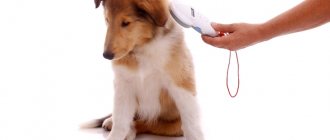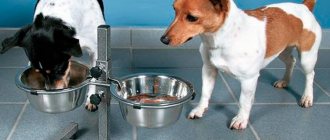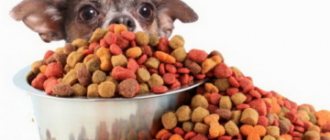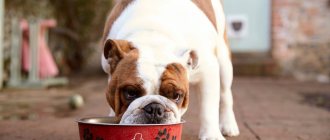Why doesn't the dog drink water?
If a dog drinks little water, this fact is not necessarily associated with health problems. It is possible that the animal is getting enough moisture from its food, especially if it is natural feeding or feeding wet commercial food. Wet food contains about 70-80% moisture. By the way, when switching a pet from dry food to natural feeding, they consume less water.
Older dogs drink less, their appetite may decrease, and at the same time the feeling of thirst decreases. Older animals forget to quench their thirst or cannot find a bowl of water due to cognitive impairment (memory impairment), or the water is too far away and the animal does not want to put in much effort to get there.
Poor health, accompanied by a number of signs, may indicate a disease. In the presence of injury, digestive upset, toothache, poisoning, pancreatitis, a foreign body entering the gastrointestinal tract, as well as being in a stressful, depressive state, dogs do not drink water or drink very little.
If your pet's refusal to drink water is not related to health problems, then you should pay attention to the quality of the water. The drinking water in the bowl should be fresh and cool and should be changed at least 2 times a day.
The dog may not like the taste and smell of water, which can be transmitted from a plastic bowl. It is better to use small ceramic bowls so that the water does not stagnate and remains cool. When changing water, the bowl should be washed and thoroughly rinsed off detergents, if used.
Perhaps the dog does not drink water because it is warm or very cold, or has an unpleasant taste due to the content of harmful metals, chlorine, and salts in the case of tap water. It is better to filter it or buy bottled.
If the steps taken do not help and the dog does not drink water, then you should think about purchasing a drinking fountain. It has been noticed that pets are more willing to drink water from a drinking fountain than from a regular bowl, because the liquid in the fountain is constantly circulating, cooled and cleaned.
Additional sources of moisture can be fruits and vegetables, which are beneficial for animals. Vegetables and fruits should be given raw. You can force a dog to drink water by improving its taste - adding berries or pieces of fruit to the water that the pet loves, but are harmless to its body. To cool the water, you can add ice cubes to it.
Another way to get your dog to drink water is to place a bowl of water near the dog's sleeping area or in areas that the dog visits most often. You can give your pet a treat or otherwise praise him every time he drinks water.
What kind of dog needs water?
First of all, it must be clean.
Regular running tap water is best. If it contains too much chlorine, it should be left to sit for several hours. If it is of such poor quality that you do not risk using it as food for yourself, you should not give it to your dog either. In this case, pass the water through a filter or give it settled boiled water. You can also give bottled water that you use for cooking yourself.
An important point is that water, even the best, should not stagnate in the bowl. It needs to be changed, even if the dog hardly drinks it. Water should always be fresh; this is very important for the health of your pet. Bacteria quickly multiply in stagnant water; even when boiled, dust settles and spoils. It must be changed at least once a day, preferably more often.
Why does a dog drink water often?
In rare cases, it is normal for a dog to drink large amounts of water. One of the reasons is a dry diet, because dry food contains only 5-10% moisture. Lack of moisture in the feed makes the animal thirsty, so clean drinking water must be freely available. Its quality is an important factor. Boiled water does not quench thirst and therefore animals may drink frequently.
Feeding your pet food from the human table with a high salt content leads to increased thirst. In this case, frequent drinking is not as harmful as the food itself.
Nursing bitches and puppies consume a lot of water compared to adults leading a normal lifestyle. Bitches during estrus drink more than males, older dogs drink often, but in small portions due to the fact that their body retains moisture less well.
The volume of fluid consumed is affected by weather conditions, so in the heat animals are more likely to feel thirsty. Activity level matters too. After strenuous physical activity and active games, dogs drink a lot of water and experience extreme thirst. When going outside for active training or games, it is advisable to take a bottle of drinking water with you so that the animal has the opportunity to quench its thirst.
Excessive thirst may occur in animals undergoing treatment. Some medications can cause thirst, such as anti-inflammatory drugs, medications for heart failure, and medications for neurological diseases.
If a pet drinks more than 80-100 ml of water per 1 kg of animal body weight, then this fact should cause concern. But limiting fluid intake if there are signs of illness (except vomiting and swelling) cannot be done until a veterinarian diagnoses the illness.
Increased thirst is observed in animals with kidney disease, diabetes, Cushing's disease (endocrine disease), and urinary tract infections.
How much water should there be
Quite often you can read about a certain volume of fluid that a dog should receive daily. Usually this is about 50 ml per 1 kg of pet weight.
Many owners, based on this “formula,” notice that the dog drinks little water or, conversely, too much. However, trying to reach an average denominator does not work in this case.
There are too many factors that influence how much water a dog should drink: body composition, time of year, age, activity level, coat length and even gender.
Pregnant and nursing mothers drink a lot, because they need to provide fluid to both their bodies and their growing babies, who receive moisture through the placenta or, after birth, with milk.
Puppies drink more than adult pets due to specific metabolism during the growth stage. Typically, older dogs drink a lot, in small portions and often, as the body retains moisture less and less well. As a rule, females drink more than males, especially during heat.
Pets who eat cereals, soups and meat drink less than those who eat dry food.
How long can a dog live without water?
It is known that a dog can survive without water for 2-3 days. Environmental factors largely influence, in particular air temperature and humidity, the level of activity of the animal itself and the type of food consumed. Naturally, a dog that is without water, but feeds on the flesh of animals, will live longer than an animal that does not have the opportunity to eat.
Lack or absence of water leads to dehydration. With a lack of moisture, the functionality of internal organs, in particular the liver and kidneys, is impaired. As a result, dehydration leads to the death of the animal.
Dehydration can be determined by several signs. To do this, you need to pull up the folds of skin above the upper part of the shoulder blade and lower it; if there is no lack of moisture, then the skin will quickly return to its original position, otherwise the skin slowly returns to its place and even remains stretched for some time. You need to check your gums; smooth and moist gums indicate a normal level of moisture, while dry, sticky and pale gums indicate a lack of moisture in the body. When dehydrated, animals have dry and sunken eyes, a dry nose and tongue, and thick saliva.
How much water should a dog drink
The daily norm for adults is 30-50 ml of water per 1 kg of animal body weight, for example, a pet weighing 10 kg should drink 300-500 ml of liquid every day. Puppies are given about ½ glass of water every 2 hours.
In general, the amount of water per day depends on several factors, including the type of feeding, the size and age of the animal, activity level, and weather conditions.
In case of mild dehydration, without vomiting, the pet is given a small amount of water - 1 tsp. small dog and 1-2 tbsp. l. large, every 10 minutes for several hours. You should not allow your animal to drink a lot of water, as this may cause vomiting.
How to determine how much water a dog drinks
Observation will help determine the amount of fluid your pet consumes. To do this, fill the bowl with water every day at approximately the same time, filling the bowl to the same level. At the end of the day or before changing the water, you should pay attention to the remaining water and draw appropriate conclusions.
If your dog drinks from the toilet
Some dogs drink water from the toilet, and there may be several reasons for this. The main reason is the lack of other opportunities to quench thirst. Owners sometimes forget to fill the bowl with water, leaving animals with no other option but to drink water from the toilet. In human eyes, drinking from a toilet is disgusting, but animals don’t think about it; for them, the toilet is a source of quenching their thirst and nothing more.
Dogs prefer to drink from the toilet rather than from a bowl because the water in the toilet is cool, and staying in a bathtub or toilet may seem comfortable for animals, because these rooms are quite cool and calm.
Drinking from the toilet bowl does not harm the health of the animal if there are no residues of chemicals contained in disinfectant detergents in the water and on the walls of the toilet bowl. Chemicals that enter the body cause gastrointestinal disorders and lead to poisoning.
If you have a close relationship with your pet and he is allowed to lick the hands and faces of family members, then you should not allow the dog to drink from the toilet. Bacteria on the fur and in the mouth end up on human skin, which is not hygienic and can be hazardous to health.
You can prevent your dog from trying to drink water from the toilet by closing the toilet door, lowering the toilet lid, filling the bowl with liquid in a timely manner, or purchasing a ceramic bowl or fountain drinker, as animals love cool running water.
What kind of water can you give your dog?
The ideal option is running water, which, if left in the bowl for a long time, should be renewed periodically. It is important to wash your water bowl every day, even if it looks clean.
Ordinary tap water is quite suitable, if it is not of absolutely terrible quality, it’s good if the water is filtered.
If your tap water is so terrible that you yourself do not risk cooking food with it, it is also better not to give it to your dog, or to boil it first. We are talking about the worst quality, since many people now do not cook with tap water, even if it is acceptable. In other cases, there is no need to boil water for the dog.
If your tap water has a lot of chlorine, let it sit before giving your dog water.
Some people give their dogs mineral water. This approach is justified only if there is nothing else at hand and the dog is thirsty. There is no other reason to give your pet mineral water, and carbonated water is not acceptable for a dog. If, for example, on the road, it happens that there is nothing but carbonated mineral water, shake and open the bottle so that the maximum amount of gases comes out.
Danger of water from puddles and ponds
Lake and river water does not pose a serious danger, but stagnant reservoirs and puddles may contain protozoan organisms that cause health problems, in particular diarrhea and more serious disorders of the gastrointestinal tract. Such organisms include Giardia and Cryptosporidium. Therefore, you should not allow your dog to drink from puddles, lakes, or rivers.
Similar articles:
- How not to feed a dog
- Feeding dogs in hot weather
- Is it possible to give eggs to dogs?
- Is it possible to give dogs onions?
- Feeding a pregnant and lactating dog
- Dairy products for dogs











